Effect of Voltage Pulse Width and Synchronized Substrate Bias in High-Power Impulse Magnetron Sputtering of Zirconium Films
Abstract
1. Introduction
2. Materials and Methods
3. Results and Discussion
3.1. The Comparison between HiPIMS Discharge Behaviors of Zr at the Difference Deposition Pressure and Voltage Pulse Width
3.2. Effects of the Pulse Width on the Zr Film Structure
3.3. Effects of Synchronized Pulse Substrate Bias on the Zr Film Structure
3.4. Effects of Deposition Pressure on the Zr Film Structure
4. Conclusions
Author Contributions
Funding
Institutional Review Board Statement
Informed Consent Statement
Data Availability Statement
Acknowledgments
Conflicts of Interest
References
- Pierson, H.O. Handbook of Refractory Carbides and Nitrides, 1st ed.; Noyes Publications: Westwood, NJ, USA, 1996; pp. 55–80. [Google Scholar]
- Fisher, E.S.; Renken, C.J. Single-crystal elastic moduli and the hcp→bcc transformation in Ti, Zr, and Hf. Phys. Rev. 1964, 135, A482. [Google Scholar] [CrossRef]
- Toth, L.E. Transition Metal. Carbides and Nitrides; Academic Press: New York, NY, USA, 1971; pp. 1–25. [Google Scholar]
- Tung, H.-M.; Wu, P.-H.; Yu, G.-P.; Huang, J.-H. Microstructures, mechanical properties and oxidation behavior of vacuum annealed TiZrN thin films. Vacuum 2015, 115, 12–18. [Google Scholar] [CrossRef]
- Lugscheider, E.; Knotek, O.; Barimani, C.; Leyendecker, T.; Lemmer, O.; Wenke, R. PVD hard coated reamers in lubricant-free cutting. Surf. Coat. Technol. 1999, 112, 146–151. [Google Scholar] [CrossRef]
- Ashcheulov, P.; Skoda, R.; Skarohlid, J.; Taylor, A.; Fendrych, F.; Kratochvílová, I. Layer protecting the surface of zirconium used in nuclear reactors. Recent. Pat. Nanotech. 2016, 10, 59–65. [Google Scholar] [CrossRef] [PubMed]
- Hollis, K.J.; Hawley, M.E.; Dickerson, P.O. Characterization of thermal diffusion related properties in plasma sprayed zirconium coatings. J. Therm. Spray Techn. 2012, 21, 409–415. [Google Scholar] [CrossRef]
- Hollis, K.J. Zirconium diffusion barrier coatings for uranium fuel used in nuclear reactors. Adv. Mater. Process. 2010, 168, 57–59. [Google Scholar]
- Kang, Y.C.; Milovancev, M.M.; Clauss, D.A.; Lange, M.A.; Ramsier, R.D. Ultra-high vacuum investigation of the surface chemistry of zirconium. J. Nucl. Mater. 2000, 281, 57–64. [Google Scholar] [CrossRef]
- Darolia, R. Thermal barrier coatings technology: Critical review, progress update, remaining challenges and prospects. Int. Mater. Rev. 2013, 58, 315–348. [Google Scholar] [CrossRef]
- Northwood, D.O. The development and applications of zirconium alloys. Mater. Des. 1985, 6, 58–70. [Google Scholar] [CrossRef]
- Thomsen, P.; Larsson, C.; Ericson, L.E.; Sennerby, L.; Lausmaa, J.; Kasemo, B. Structure of the interface between rabbit cortical bone and implants of gold, zirconium and titanium. J. Mater. Sci. Mater. Med. 1997, 8, 653–665. [Google Scholar] [CrossRef]
- Mehjabeen, A.; Song, T.; Xu, W.; Tang, H.P.; Qian, M. Zirconium Alloys for Orthopaedic and Dental Applications. Adv. Eng. Mater. 2018, 20, 1800207. [Google Scholar] [CrossRef]
- Wu, H.-C.; Huang, C.-J.; Youh, M.-J.; Tseng, C.-L.; Chen, H.-T.; Li, Y.-Y.; Sakoda, A. Thin-walled carbon nanotubes grown using a zirconium catalyst. Carbon 2010, 48, 1897–1901. [Google Scholar] [CrossRef]
- Usmani, B.; Vijay, V.; Chhibber, R.; Dixit, A. Optimization of sputtered zirconium thin films as an infrared reflector for use in spectrally-selective solar absorbers. Thin Solid Film. 2017, 627, 17–25. [Google Scholar] [CrossRef]
- Lim, J.-W.; Bae, J.W.; Zhu, Y.F.; Lee, S.; Mimura, K.; Isshiki, M. Improvement of Zr film purity by using a purified sputtering target and negative substrate bias voltage. Surf. Coat. Technol. 2006, 201, 1899–1901. [Google Scholar] [CrossRef]
- Baudry, A.; Boyer, P.; Brunel, M.; Luche, M.C. Structure and magnetic behaviour of holmium-zirconium multilayers. J. Phys. Condens. Matter. 2000, 12, 3719. [Google Scholar] [CrossRef]
- Smardz, L. Structure and magnetic properties of Fe/Zr multilayers. J. Alloy. Compd. 2005, 395, 17. [Google Scholar] [CrossRef]
- Singh, A.; Kuppusami, P.; Thirumurugesan, R.; Ramaseshan, R.; Kamruddin, M.; Dash, S.; Ganesan, V.; Mohandas, E. Study of microstructure and nanomechanical properties of Zr films prepared by pulsed magnetron sputtering. Appl. Surf. Sci. 2011, 257, 9909–9914. [Google Scholar] [CrossRef]
- Chakraborty, J.; Kumar, K.K.; Mukherjee, S.; Ray, S.K. Stress, texture and microstructure of zirconium thin films probed by X-ray diffraction. Thin Solid Film. 2008, 516, 8479–8486. [Google Scholar] [CrossRef]
- Luo, H.; Gao, F.; Billard, A. Tunable microstructures and morphology of zirconium films via an assist of magnetic field in HiPIMS for improved mechanical properties. Surf. Coat. Technol. 2019, 374, 822–832. [Google Scholar] [CrossRef]
- Ul-Hamid, A. The effect of deposition conditions on the properties of Zr-carbide, Zr-nitride and Zr-carbonitride coatings—A review. Mater. Adv. 2020, 1, 988–1011. [Google Scholar] [CrossRef]
- Lundin, D.; Minea, T.; Gudmundsson, J.T. (Eds.) High Power Impulse Magnetron Sputtering: Fundamentals, Technologies, Challenges and Applications; Elsevier: Amsterdam, The Netherlands, 2019; ISBN 9780128124543. [Google Scholar]
- Anders, A. Tutorial: Reactive high power impulse magnetron sputtering (R-HiPIMS). J. Appl. Phys. 2017, 121, 171101. [Google Scholar] [CrossRef]
- Anders, A.; Andersson, J.; Ehiasarian, A. High power impulse magnetron sputtering: Current-voltage-time characteristics indicate the onset of sustained self-sputtering. J. Appl. Phys. 2007, 102, 113303. [Google Scholar] [CrossRef]
- Kouznetsov, V.; Macak, K.; Schneider, J.; Helmersson, U.; Petrov, I. Hybrid HIPIMS and DC magnetron sputtering deposition of TiN coatings: Deposition rate, structure and tribological properties. Surf. Coat. Technol. 1999, 12, 290. [Google Scholar] [CrossRef]
- Machunze, R.; Ehiasarian, A.; Tichelaar, F.; Janssen, G.; Ehiasarian, A. Stress and texture in HIPIMS TiN thin films. Thin Solid Film. 2009, 518, 1561–1565. [Google Scholar] [CrossRef]
- Samuelsson, M.; Lundin, D.; Jensen, J.; Raadu, M.A.; Gudmundsson, J.T.; Helmersson, U. On the film density using high power impulse magnetron sputtering. Surf. Coat. Technol. 2010, 205, 591–596. [Google Scholar] [CrossRef]
- Kuo, C.C.; Lin, Y.T.; Chan, A.; Chang, J.T. High Temperature Wear Behavior of Titanium Nitride Coating Deposited Using High Power Impulse Magnetron Sputtering. Coatings 2019, 9, 555. [Google Scholar] [CrossRef]
- West, G.; Kelly, P.; Barker, P.; Mishra, A.; Bradley, J. Measurements of Deposition Rate and Substrate Heating in a HiPIMS Discharge. Plasma Process. Polym. 2009, 6, S543–S547. [Google Scholar] [CrossRef]
- Elmkhah, H.; Attarzadeh, F.; Fattah-alhosseini, A.; Kim, K.H. Microstructural and electrochemical comparison between TiN coatings deposited through HIPIMS and DCMS techniques. J. Alloy. Compd. 2018, 735, 422–429. [Google Scholar] [CrossRef]
- Greczynski, G.; Lu, J.; Jensen, J.; Bolz, S.; Kölker, W.; Schiffers, C.; Lemmer, O.; Greene, J.E.; Hultman, L. A review of metal-ion-flux-controlled growth of metastable TiAlN by HIPIMS/DCMS co-sputtering. Surf. Coat. Technol. 2014, 257, 15–25. [Google Scholar] [CrossRef]
- Vetushka, A.; Ehiasarian, A.P. Plasma dynamic in chromium and titanium HIPIMS discharges. J. Phys. D Appl. Phys. 2008, 41, 015204. [Google Scholar] [CrossRef]
- Ferreira, F.; Serra, R.; Oliveira, J.C.; Cavaleiro, A. Effect of peak target power on the properties of Cr thin films sputtered by HiPIMS in deep oscillation magnetron sputtering (DOMS) mode. Surf. Coat. Technol. 2014, 258, 249–256. [Google Scholar] [CrossRef]
- Gudmundsson, J.T.; Alami, J.; Helmersson, U. Spatial and temporal behavior of the plasma parameters in a pulsed magnetron discharge. Surf. Coat. Technol. 2002, 161, 249–256. [Google Scholar] [CrossRef]
- Sønderby, S.; Aijaz, A.; Helmersson, U.; Sarakinos, K.; Eklund, P. Deposition of yttria-stabilized zirconia thin films by high power impulse magnetron sputtering and pulsed magnetron sputtering. Surf. Coat. Technol. 2014, 240, 1–6. [Google Scholar] [CrossRef]
- Zhao, X.L.; Jin, J.; Cheng, J.C.; Lee, J.W.; Wu, K.H.; Liu, K.C. Effect of pulsed off-times on the reactive HiPIMS preparation of zirconia thin films. Vacuum 2015, 118, 38–42. [Google Scholar] [CrossRef]
- Kuo, C.C.; Lin, C.H.; Lin, Y.T.; Chang, J.T. Effects of Cathode Voltage Pulse Width in High Power Impulse Magnetron Sputtering on the Deposited Chromium Thin Films. Coatings 2020, 10, 542. [Google Scholar] [CrossRef]
- Zuo, X.X.; Ke, P.P.; Chen, R.; Li, X.; Odén, M.; Wang, A. Discharge state transition and cathode fall thickness evolution during chromium HiPIMS discharge. Phys. Plasmas 2017, 24, 083507. [Google Scholar] [CrossRef]
- Horwat, D.; Anders, A. Compression and strong rarefaction in high power impulse magnetron sputtering discharges. J. Appl. Phys. 2010, 108, 123306. [Google Scholar] [CrossRef]
- Tsukamoto, K.; Tamura, T.; Matsusaki, H.; Tona, M.; Yamamoto, H.; Nakagomi, Y.; Nishida, H.; Hirai, Y.; Nishimiya, N.; Sanekata, M.; et al. Time-of-flight mass spectrometric diagnostics for ionized and neutral species in high-power pulsed magnetron sputtering of titanium. Jpn. J. Appl. Phys. 2020, 59, SHHB05. [Google Scholar] [CrossRef]
- Bohlmark, J.; Lattemann, M.; Gudmundsson, J.T.; Ehiasarian, A.P.; Gonzalvo, Y.A.; Brenning, N.; Helmersson, U. The ion energy distributions and ion flux composition from a high power impulse magnetron sputtering discharge. Thin Solid Film. 2006, 515, 1522–1526. [Google Scholar] [CrossRef]
- Anders, A. A structure zone diagram including plasma-based deposition and ion etching. Thin Solid Film. 2010, 518, 4087–4090. [Google Scholar] [CrossRef]
- Alami, J.; Maric, Z.; Busch, H.; Klein, F.; Grabowy, U.; Kopnarski, M. Enhanced ionization sputtering: A concept for superior industrial coatings. Surf. Coat. Technol. 2014, 255, 43–51. [Google Scholar] [CrossRef]
- Mahieu, S.; Depla, D. Reactive sputter deposition of TiN layers: Modelling the growth by characterization of particle fluxes towards the substrate. J. Phys. D Appl. Phys. 2009, 42, 053002. [Google Scholar] [CrossRef]
- De Monteynard, A.; Schuster, F.; Billard, A.; Sanchette, F. Properties of chromium thin films deposited in a hollow cathode magnetron powered by pulsed DC or HiPIMS. Surf. Coat. Technol. 2017, 330, 241–248. [Google Scholar] [CrossRef]
- Wu, S.; Chen, H.; Du, X.; Liu, Z. Effect of deposition power and pressure on rate deposition and resistivity of titanium thin films grown by DC magnetron sputtering. Spectrosc. Lett. 2016, 49, 514–519. [Google Scholar] [CrossRef]
- Hippler, R.; Cada, M.; Stranak, V.; Helm, C.A.; Hubicka, Z. Pressure dependence of singly and doubly charged ion formation in a HiPIMS discharge. J. Appl. Phys. 2019, 125, 013301. [Google Scholar] [CrossRef]
- Seshan, K. (Ed.) Handbook of Thin Film Deposition, 3rd ed.; Elsevier: Amsterdam, The Netherlands, 2012; p. 53. ISBN 978-1-4377-7873-1. [Google Scholar]

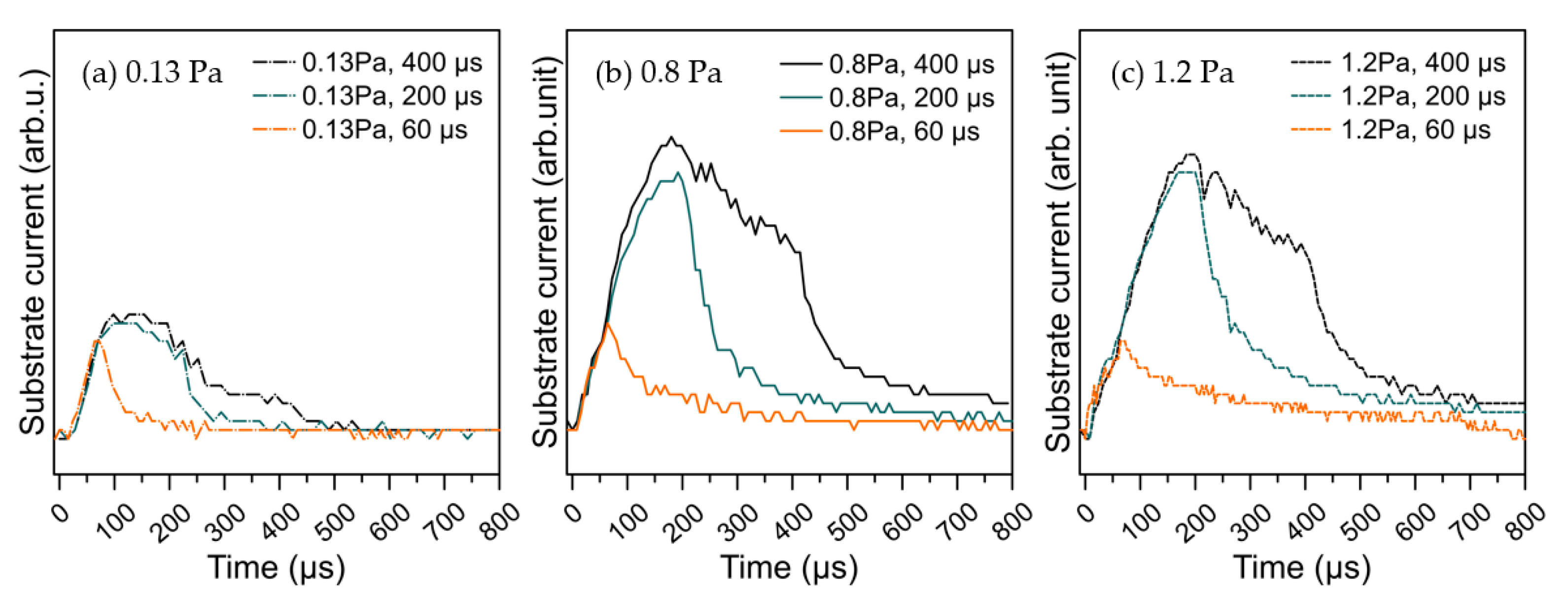
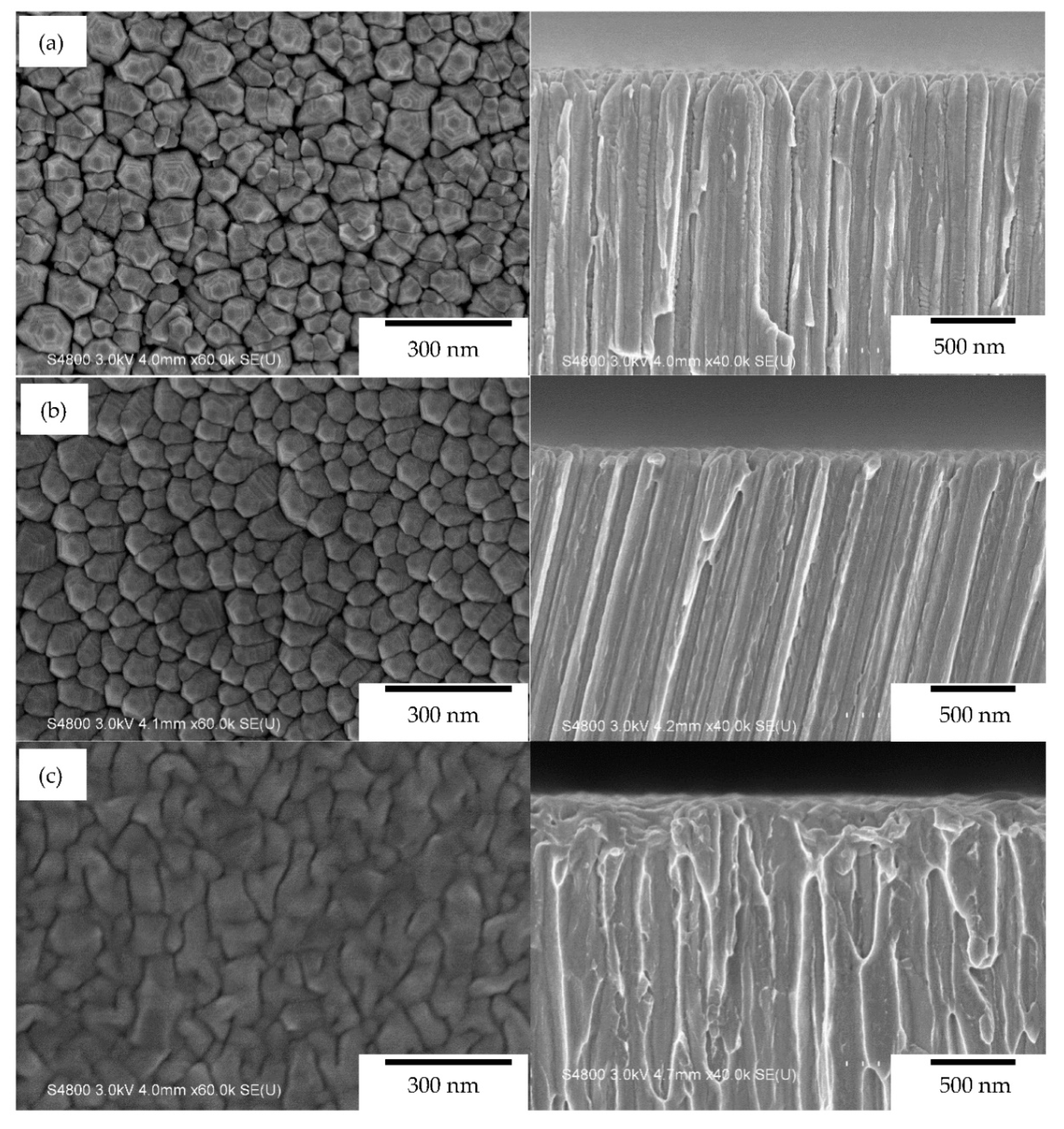
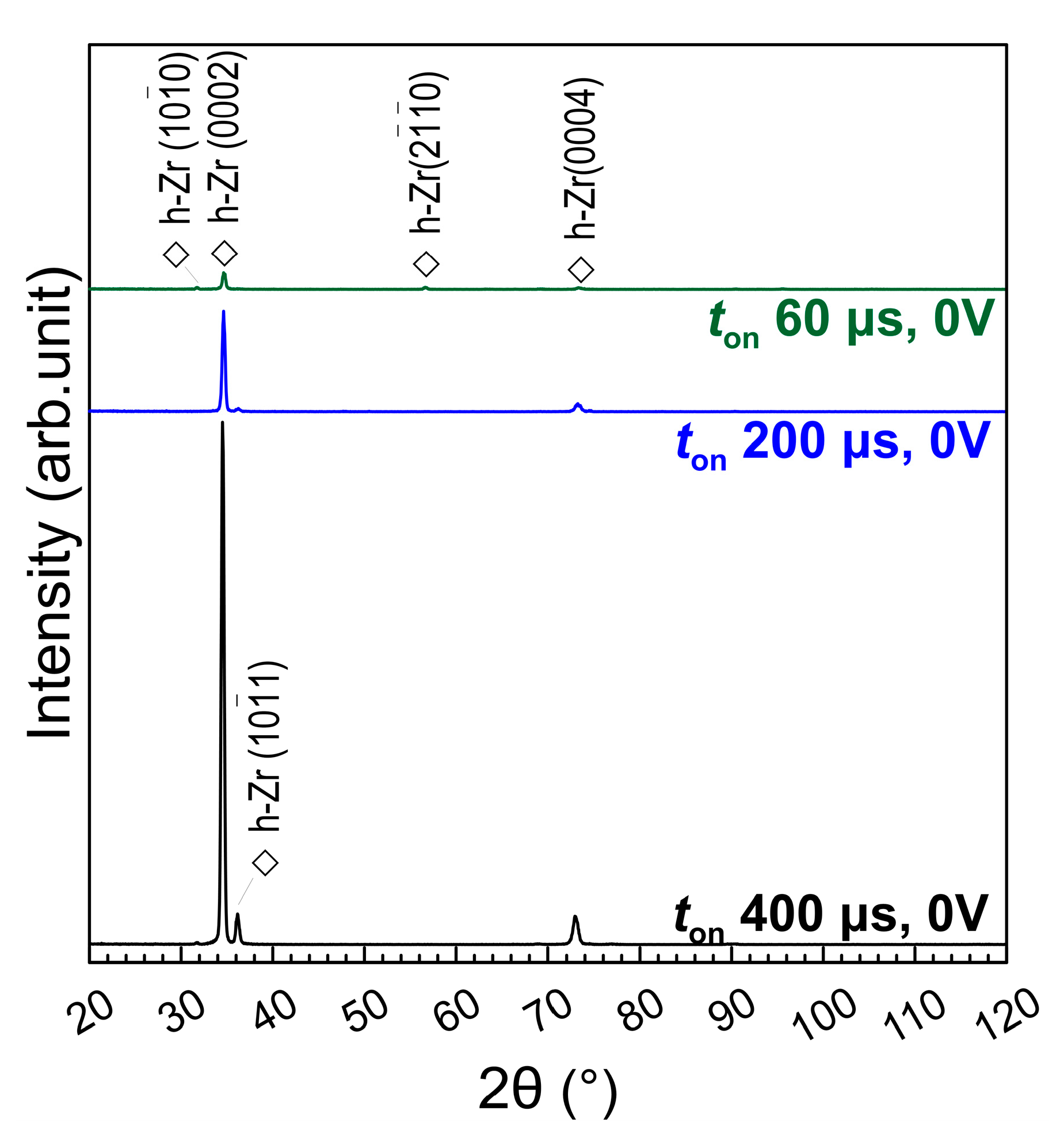


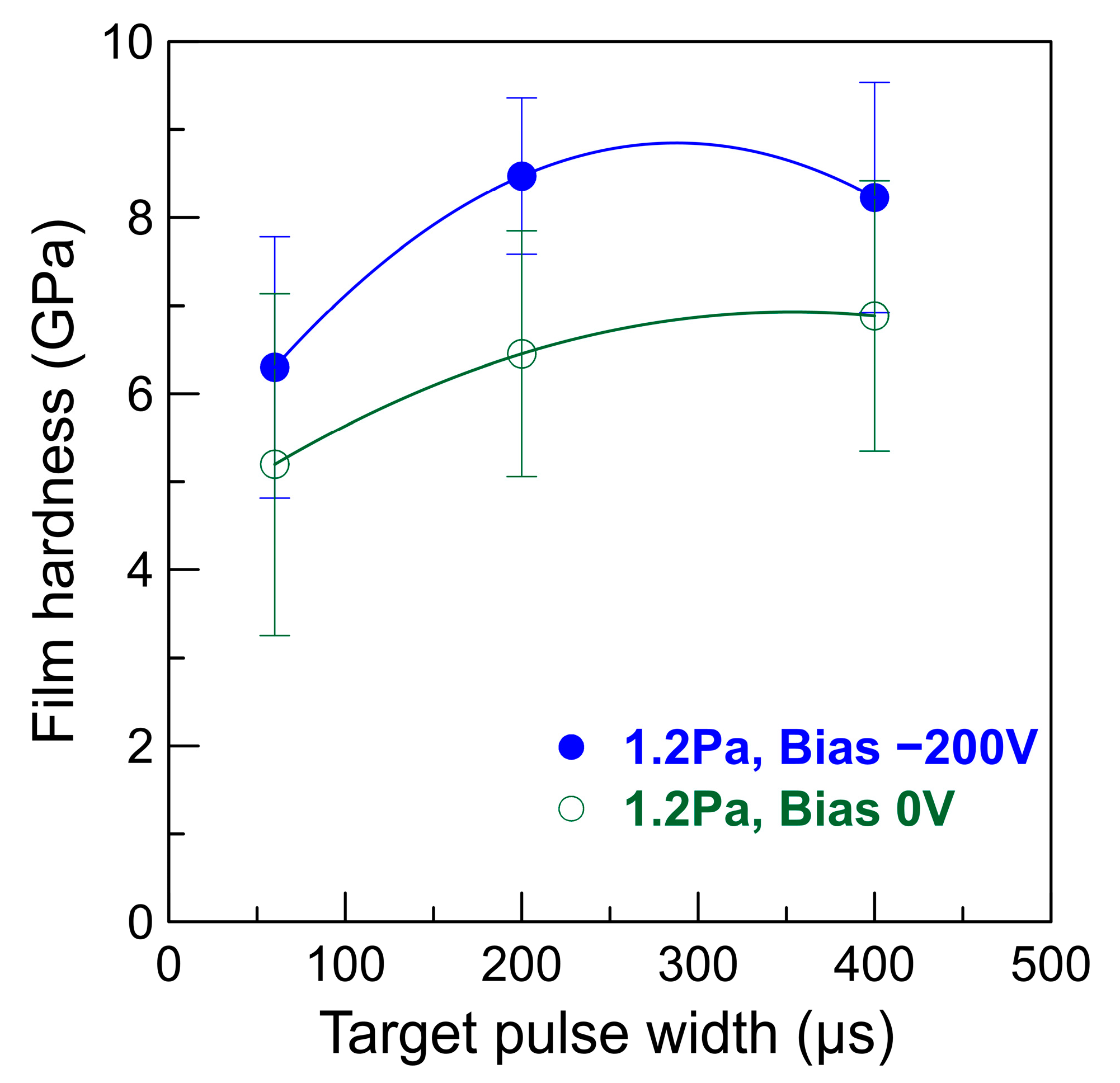
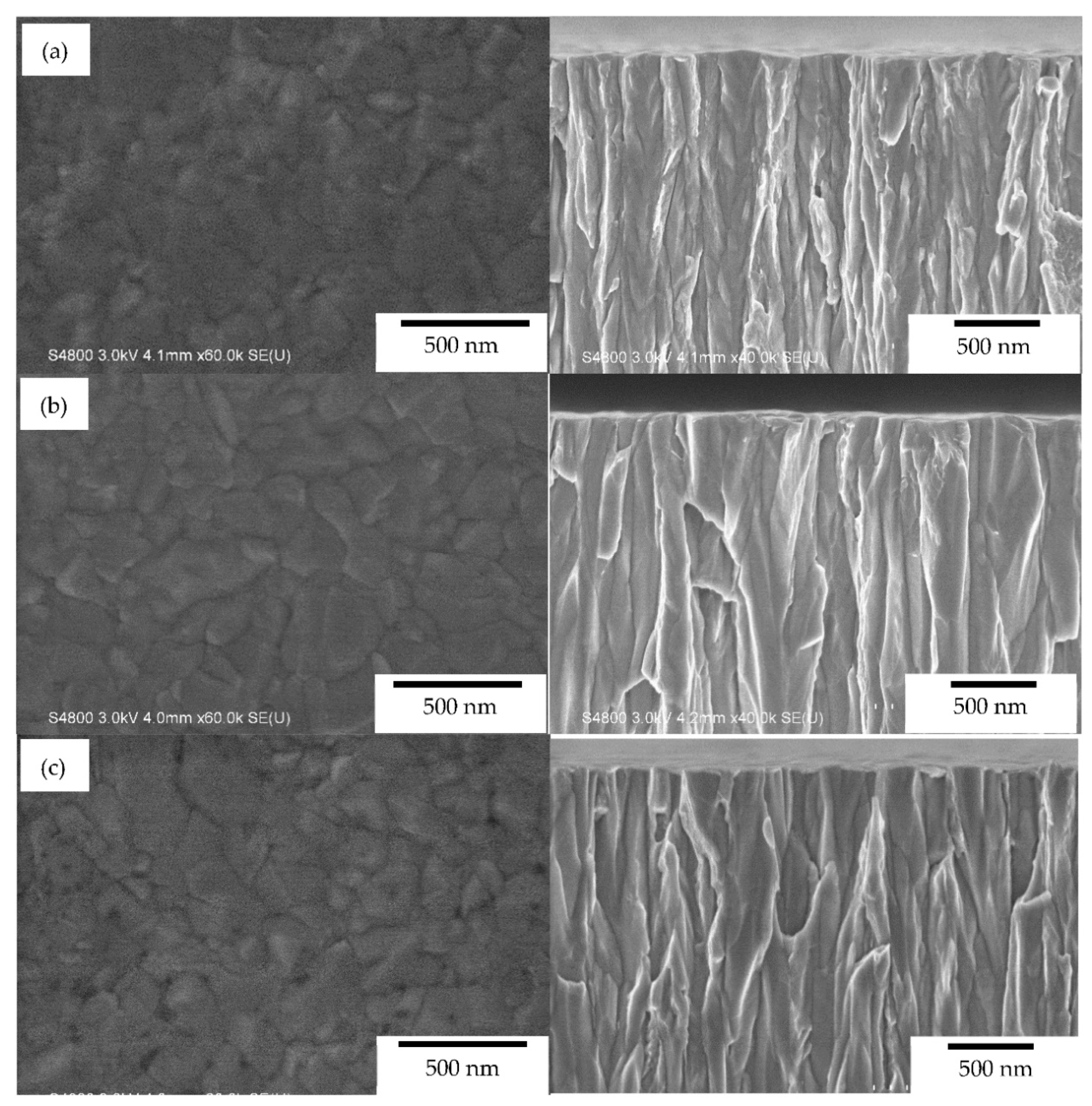


| Deposition Parameters | Value | |
|---|---|---|
| Atmosphere | Argon pressure (Pa) | 0.8, 1.2 |
| Target HiPIMS power | Average power (kW) | 3 |
| Peak voltage (V) | −987~−877 | |
| Peak current (A) | 214~156 | |
| Pulse frequency (Hz) | 410, 105, 58 | |
| Pulse width (μs) | 60, 200, 400 | |
| Pulse duty cycle (%) | ~2.5 | |
| Zr ion bombardment | Synchronized bias voltage pulse | −1000 V (pulse width 120, 400, 800 μs) |
| Bombardment time | 40 s | |
| Zr film deposition | Synchronized bias voltage pulse | Ground 0 V, −200 V (pulse width 120, 400, 800 μs) |
| Deposition time | 40 min | |
| Deposition temperature (°C) | 190~200 | |
Publisher’s Note: MDPI stays neutral with regard to jurisdictional claims in published maps and institutional affiliations. |
© 2020 by the authors. Licensee MDPI, Basel, Switzerland. This article is an open access article distributed under the terms and conditions of the Creative Commons Attribution (CC BY) license (http://creativecommons.org/licenses/by/4.0/).
Share and Cite
Kuo, C.-C.; Lin, C.-H.; Chang, J.-T.; Lin, Y.-T. Effect of Voltage Pulse Width and Synchronized Substrate Bias in High-Power Impulse Magnetron Sputtering of Zirconium Films. Coatings 2021, 11, 7. https://doi.org/10.3390/coatings11010007
Kuo C-C, Lin C-H, Chang J-T, Lin Y-T. Effect of Voltage Pulse Width and Synchronized Substrate Bias in High-Power Impulse Magnetron Sputtering of Zirconium Films. Coatings. 2021; 11(1):7. https://doi.org/10.3390/coatings11010007
Chicago/Turabian StyleKuo, Chin-Chiuan, Chun-Hui Lin, Jing-Tang Chang, and Yu-Tse Lin. 2021. "Effect of Voltage Pulse Width and Synchronized Substrate Bias in High-Power Impulse Magnetron Sputtering of Zirconium Films" Coatings 11, no. 1: 7. https://doi.org/10.3390/coatings11010007
APA StyleKuo, C.-C., Lin, C.-H., Chang, J.-T., & Lin, Y.-T. (2021). Effect of Voltage Pulse Width and Synchronized Substrate Bias in High-Power Impulse Magnetron Sputtering of Zirconium Films. Coatings, 11(1), 7. https://doi.org/10.3390/coatings11010007




